SQL语句大全
界面工具使用sql语句以查为主,当前以cmd中使用为背景
1。进入mysql安装路径,如:C:\Program Files\MySQL\MySQL Server 8.0\bin
2。cmd登录mysql:mysql -P 3306 -h localhost -u root -p
3。输入密码,如:123456
注:ERROR 2003 (HY000): Can't connect to MySQL server on 'localhost' (10061),需启动Mysql服务

一、常用查询语句-数据
1、as关键字
1)给字段起别名:select id as 序号,name as 名字,age as 年龄 from students;

2)给表起别名:select s.id,s.name,s.age from students as s;
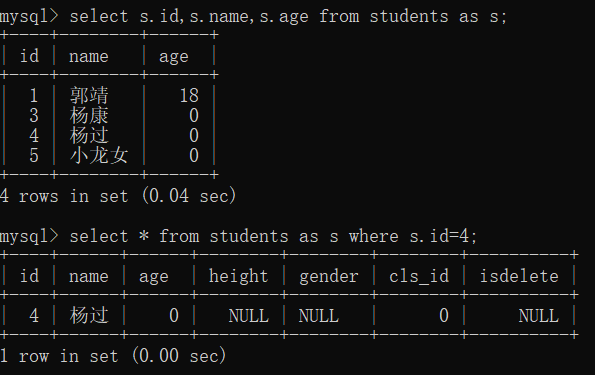
2、条件语句查询:where后面支持多种运算符,进行条件的处理
1)比较运算符:=、>、>=、<、<=、!=、<>
例1:sleect * from students where isdelete=1; 查询已被删除的学生

例2:select * from students where id>3; 查询编号大于3的学生

例3:select * from studnets where id <= 4; 查询编号不大于4的学生

例4:select * from students where name !='黄蓉'; 查询姓名不是“黄蓉”;

2)逻辑运算符 :and、or、not
例1:select * from students where id<3 and gender='女'; 查询编号小于3的女同学

例2:select * from students where name='小龙女' or age=18; 查询姓名为小龙女或年龄为18的学生

3)模糊查询:like(%任意多个字符;_一个字符)
例1:select * from students where name like'郭%'; 查询姓郭的学生
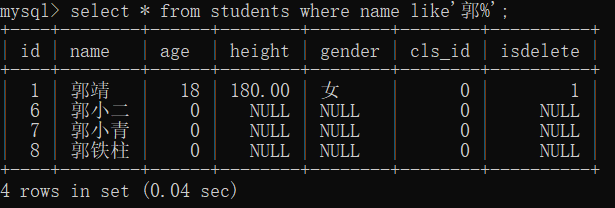
例2:select * from students where name like ‘郭_'; 查询姓黄且名是一个字的学生

4)范围查询:in、between ... and ...
例1:select * from students where id in (1,6,8); 查询非连续范围:查询编号是1或6或8的学生

例2:select * from students where id between 1 and 4; 查询一个连续范围:查询编号为1至4的学生

5)空判断
例1:select * from students where height is not null; 查询填写了身高的学生

例2:select * from students where gender is null; 查询没有填写姓名的学生
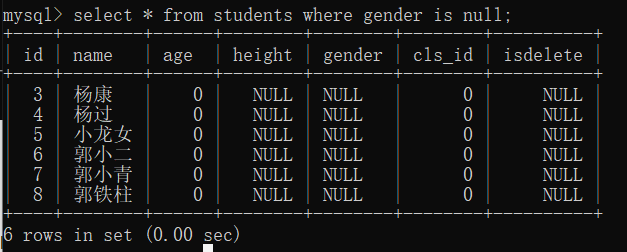
3、排序
例1:select * from students where gender='男' and isdelete=1 order by height desc; 查询删除的男生信息,按身高降序

例2:select * from students where isdelete=1 order by name; 查询删除学生信息,按名称升序
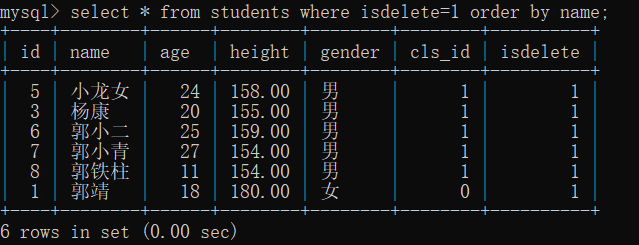
例3:select * from students order by height desc,age desc; 先按照身高从高–>矮排序,当身高相同时 按照年龄从大–>小排序

4、分页
说明
从start开始,获取count条数据
start默认值为0
也就是当用户需要获取数据的前n条的时候可以直接写上 ........limit n;
例1:select * from students where gender='男' limit 0,3; 查询前三行男生信息

5、聚合函数
1)总数:count
count(*) 表示计算总行数,括号中写星与列名,结果是相同的
select count(*) from students;

2)最大数:max
max(列) 表示求此列的最大值
select max(id) from students where gender='男'; 查询男生中,编号最大的值

3)最小数:min
min(列) 表示求此列的最小值
select min(id) from students where isdelete=1; 查询已删除的学生最小编号值

4)求和:sum
sum(列) 表示求此列的和
例1:select sum(age) from students where gender='男'; 查询男生的总年龄

例2:select sum(age)/count(*) from students where gender='男'; 查询男生的平均年龄

5)平均值:avg
avg(列) 表示求此列的平均值
select avg(age) from students where gender='男'; 查询男生的平均年龄

6、分组
1)group by
select gender from students group by gender; 按性别分组
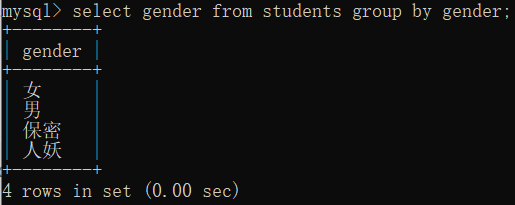
2)group by + group_concat()
group_concat(字段名)根据分组结果,使用group_concat()来放置每一个分组中某字段的集合
例1:select gender,group_concat(name) from students group by gender;

例2:select gender,group_concat(id) from students group by gender;

3)group by + 聚合函数
通过集合函数来对这个值的集合做一些操作
例1:select gender,avg(age) from students group by gender; 分别统计各性别的平均年龄

例2:select gender,count(*) from students group by gender; 分别统计各性别的人数
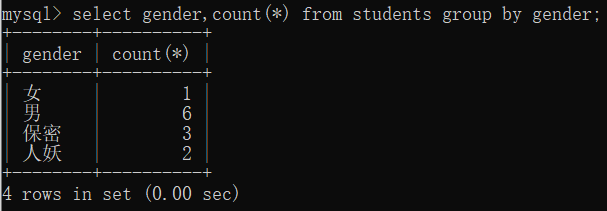
4)group by + having
having 条件表达式:用来过滤分组结果
having作用和where类似,但having只能用于group by 而where是用来过滤表数据
select gender,count(*) from students group by gender having count(*)>2;

5)group by + with rollup
with rollup的作用是:在最后新增一行,来记录当前表中该字段对应的操作结果,一般是汇总结果。
select gender,count(*) from students group by gender with rollup;

7、连接查询
查询班级表与学生表

1)内连接:inner join ... on
例1:select * from students inner join classes on students.cls_id = classes.id;

例2:select s.name,c.name from students as s inner join classes as c on s.cls_id = c.id;

2)左连接:left join ... on
select * from students as s left join classes as c on s.cls_id = c.id;
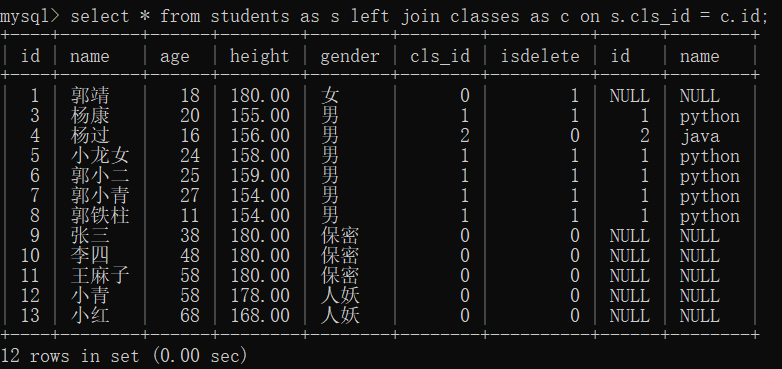
3)右连接:right join ... on
select * from students as s right join classes as c on s.cls_id = c.id;
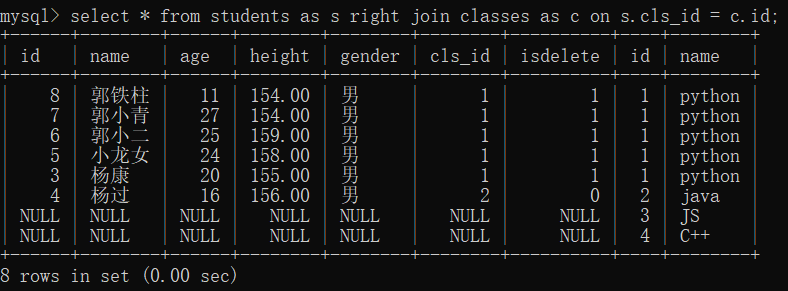
8、子查询
在一个 select 语句中,嵌入了另外一个 select 语句, 那么被嵌入的 select 语句称之为子查询语句,外部那个select语句则称为主查询.
主查询和子查询的关系
子查询是嵌入到主查询中
子查询是辅助主查询的,要么充当条件,要么充当数据源
子查询是可以独立存在的语句,是一条完整的 select 语句
1)标量子查询
例1:select * from students where age > (select avg(age) from students);
查询班级学生平均年龄
查询大于平均年龄的学生
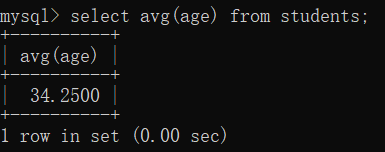

2)列级子查询
例2:select name from classes where id in (select cls_id from students);
查询还有学生在班的所有班级名字
找出学生表中所有的班级 id;找出班级表中对应的名字

3)行级子查询
例3:select * from students where (height,age) = (select max(height),max(age) from students);
查找班级年龄最大,身高最高的学生

二、常用增删改-数据
增加
说明:主键列是自动增长,但是在全列插入时需要占位,通常使用空值(0或者null) ; 字段默认值 default 来占位,插入成功后以实际数据为准
1、全列插入:值的顺序与表结构字段的顺序完全一一对应(此时字段名列表不用填写): insert into students values(0,'郭靖',18,180,'女',0);
![]()
2、部分列插入:值的顺序与给出的列顺序对应(此时根据实际的数据填写对应字段列表):insert into students(name,age) values('黄荣',33);
![]()
上面的语句一次可以向表中插入一行数据,还可以一次性插入多行数据,这样可以减少与数据库的通信
3.全列多行插入:insert into classes values(0,'python'),(0,'java');

4.部分列多行插入:insert into classes(name) values('JS'),('C++');

修改
update students set age=17,gender='男' where id=2;
![]()
删除
1、delete from students where id=2;
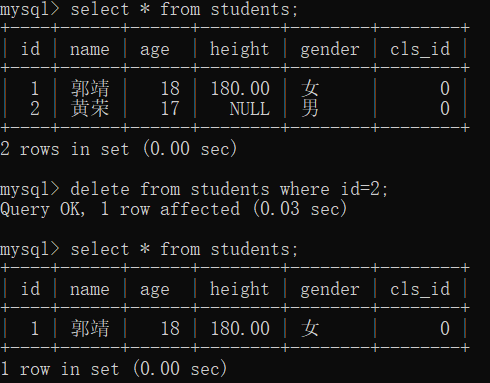
2、逻辑删除就是修改:update students set isdelete=1 where id=1;
![]()
三、不常用语句
库的操作
1、查看所有数据库:show databases;
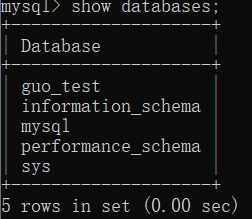
2、创建数据库:create database test1 charset=utf8;
![]()
3、删除数据库:drop database test1;
![]()
4、进入某个数据库:use guo_test;
![]()
5、查看当前使用哪个数据库:select database();
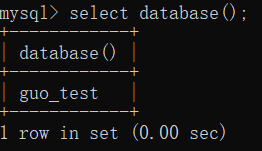
6、查看库中所有表:show tables;
![]()
表结构操作
1、创建班级表:create table classes(id int unsigned auto_increment primary key not null, name varchar(10) );
![]()
2、删除表:drop table test;
![]()
3、查看表结构:desc classes;

4、查看表结构-详细:show create table classes;
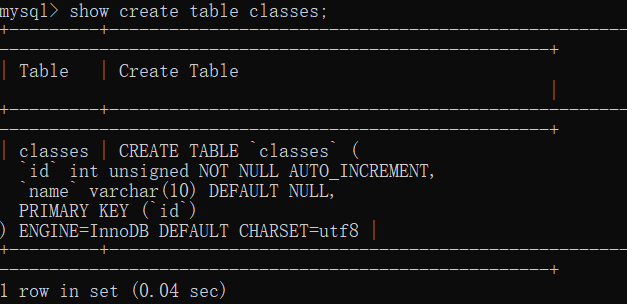
修改表字段操作
1、添加字段:alter table classes add birthday datetime;
![]()
2、修改字段-不可重名:alter table classes modify birth date not null;
![]()
3、修改字段-可重名:alter table classes change birthday birth datetime not null;
![]()
4、删除字段:alter table classes drop birth;
![]()




 浙公网安备 33010602011771号
浙公网安备 33010602011771号